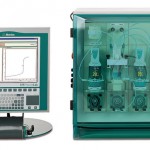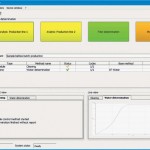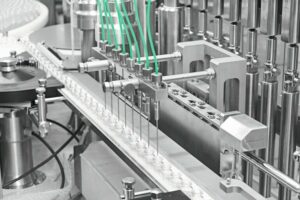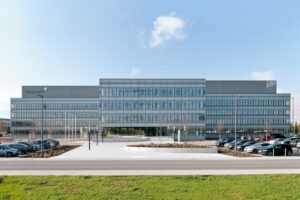The water content of many products has to be maintained within closely stipulated limits, which means that it must be checked at regular intervals during the production process. If the determination is carried out in the immediate vicinity of the process, then the waiting time for the analytical result is shortened and the product can be released earlier for further processing. ProcessLab is flexible and has a strictly modular structure, which makes customised on-site solutions possible. The water contents obtained are available centrally for monitoring or other purposes.
Frank Portala, Matthias Burkhard, Nils Geil and Alfred Steinbach
Numerous methods exist for determining water. One of these is the extremely simple but error-prone drying method using a drying oven or infrared lamp. Water content can also be determined titrimetrically or spectroscopically (e.g. with Near InfraRed spectroscopy, NIR). The Karl Fischer titration (KFT) used in Metrohm’s atline analysis system is considered the most accurate and most reproducible of all water determination methods. It determines not only free water, but also the water that is adsorbed on the surface or trapped in the crystal structure. When developing his original analytical method, Karl Fischer [1] started out from the Bunsen reaction for determining sulphur dioxide in an aqueous solution. With an excess of SO2 in the presence of bases, this reaction can also be used to determine water. This is how the classic KF reagent – a solution of iodine and sulphur dioxide in a buffered mixture of pyridine and methanol [2] – came into being. Since its discovery more than seventy years ago, KFT has experienced unparalleled success. As a result of constant improvements in commercially available KF reagents, there are now various one- and two-component reagents available for different matrices and water contents.
Apart from volumetric Karl Fischer titration, there is also the possibility of generating the iodine required for the reaction coulometrically with the help of electric current, directly in the measuring cell. Whereas coulometric water determination is suitable for very low water contents, volumetric KFT is preferable for higher water contents [2 to 3].
Water determination at the process line
Determination of the water content is of crucial importance in numerous production processes. If sudden changes in water content are expected during a process, it is necessary to resort to fast inline or online measuring techniques that are frequently both complicated and expensive. If different production lines or process areas need to be monitored, the use of an atline analysis system is recommended. Here, the sample is taken manually and then fed into the analysis system. Samples from different process stages or process plants can be analysed easily in this way.
Metrohm’s ProcessLab atline analysis system has an appropriately robust type of construction for direct use in production areas and determines the water content automatically by KF titration. Each system consists of an analysis module and an operating unit with an optional touch monitor. Both the module and the unit are contained in a rugged, splash-proof housing and are therefore ideal for use in harsh production environments. ProcessLab is a novel analysis system with a modular structure throughout that can easily be adapted to any particular process conditions.
The clearly designed analysis module comprises a measuring vessel with a magnetic stirrer, a sample loop for automatic metering of the sample, one Dosino drive for exact dosing of the reagent (Hydranal Composite) and of the water standard for titer determination plus another Dosino for the conditioned solvent. Peristaltic pumps enable automated addition of methanol as well as automatic cleaning of the measuring vessel. This allows to determine the water content easily and fully automatically within a few minutes.
All analytical results are saved in a shared database, where they are available for monitoring and control purposes. Digital and analogue input/output components (I/O) allow easy integration of the system into the process surroundings. It can therefore react to different input signals, for instance by automatically measuring different parameters depending on the sample, triggering an alarm if limits are infringed or transmitting measured values as analogue 4 to 20 mA signals. The data can either be supplied to a process control system or exported via Ethernet.
The user-friendly ProcessLab Manager control and checking software facilitates straightforward and error-free operation. Its user-specific interface is characterised by a clear layout and intuitive operation; for example analysis sequences can be started by pressing a single button.
Typical process applications
Water determinations are vital in numerous production processes. Whereas water occurs as a contaminant in biofuels, when present in cosmetics and food in the correct concentration it provides the necessary consistency. Biofuels such as ethanol, biodiesel or biogas, food and beverages such as virgin olive oils or pet food and hydrofluoric acid in the plating and galvanics industries are typical applications for water determination. In the chemical sector, water is determined in salts, acids and bases, alcohols and glycols, surfactants, adhesives and alkylates, while pharmaceutical and cosmetics companies rely on water determination in the production of disinfectants and antiseptics, perfumes, shower gels, drugs, raw materials, intermediates and end products.
The atline analysis system presented here was demonstrated by determining the water content in solvents such as acetonitrile, phenol, methanol and isopropanol as well as in window cleaners. Ten repeat measurements are shown for each of the different substances together with the overall reproducibility achieved with the system (Table 1). By varying the sample volumes, reagent concentration and dosing unit size, it is possible to adjust to the determination range of a specific application and thus measure very low as well as very high water contents (Table 2).
Thanks to its modular structure, ProcessLab can be adapted to the requirements of any process, and water contents between 0.02 and 50 % can be determined in numerous intermediate and end products.
Literature
- 1. Karl Fischer, Neues Verfahren zur maßanalytischen Bestimmung des Wassergehaltes von Flüssigkeiten und festen Körpern, Angew. Chemie. 48, 394–396 (1935).
- 2. P. Bruttel and R. Schlink, Water determination by Karl Fischer titration, Metrohm Monograph (article number 8.026.5013), 80 pages (2006).
- 3. S. Grünke, Reaktionsmechanismen in der Karl-Fischer-Lösung, PhD thesis, University of Hanover, Hanover, Germany (1999).
Hall 5.1, Booth F39; Hall 10.2, Booth L15
Online-Info www.cpp-net.com/2209458
Share:








